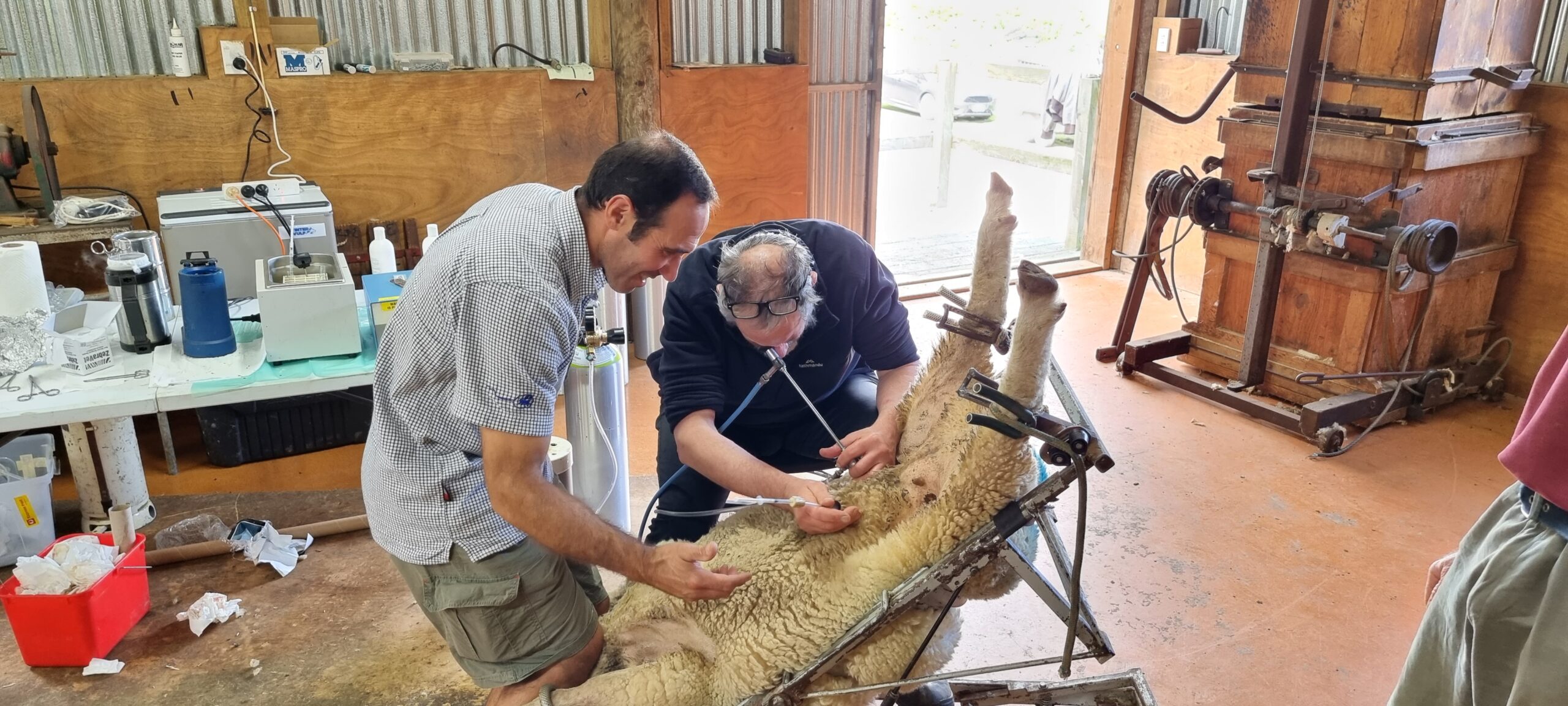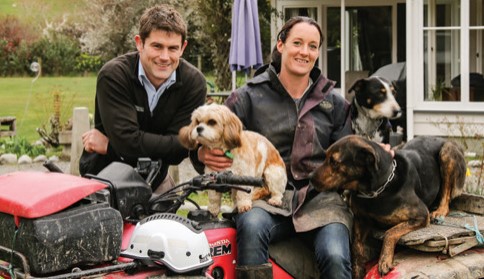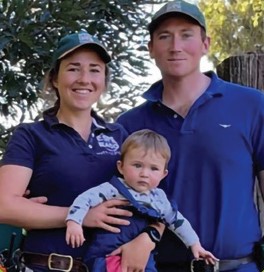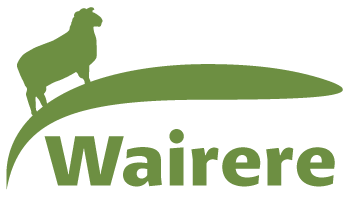Bare Hair ewes in the UK, part of a flock of 3,000 in the UK. 85% of Wairere’s embryos came from this flock, which is farmed outdoors all year round, on rented grazing, mostly with no fertiliser input.
The season
There have been extremes across the country. Half New Zealand has had a good run, other areas have been crushed by too much rain or too little.
Farmers have shown great resilience in dealing with extremes, and focusing on recovery.
Supply and demand
The world supply of food is likely to decrease as farmers reduce fertiliser input. Demand won’t decrease, though poor people will be forced to eat less protein. The USA had a 1.4% drop in GDP in the first quarter. That signals a likely recession. How will consumer habits change? During the voluntary Covid lockdown in the USA in 2020, Lean Meats had a big boost to online sales through Whole Foods/Amazon Direct for lamb mince.
One buffer is that processor margin on beef schedules have been two to three dollars per kg above the average five year margin. There is a sheep meat buffer too, not as great. Though shortage of both processing staff and shipping space have been bleeding that margin. How long will we have to wait before we get back to pre Covid normal? The New Zealand dollar is depreciating against the US dollar,
another potential buffer for exporters.
Plant based meats are struggling to maintain shelf space and market share. That’s good news. And have you noticed how the big, rich countries make the rules about GHGs? They never say that they will halve vehicle production, reduce oil and gas exploration, stop building in steel and concrete. No, blame the animals, keep the peasants busy!
Nudies or wool?
In April our Wairere team and veterinarian specialist Ian McDougall transferred 458 Bare Hair sheep embryos from the UK into recipient ewes. Ian also inseminated 637 Wairere ewes with Bare Hair sheep semen. These ewes were a mix of FE resilient, Tufguy(interbred Texel/Romney), and bare point Romneys. The program was carried out on Peter and Ali Apthorp’s farm near Pahiatua. Purebred and first cross Nudie ram lambs will be available for purchase in late February/March 2023.
Why Wairere nudies?
There are a number of New Zealand farmers already breeding towards sheep without wool. What percentage of farmers? Perhaps only two to three percent, but that number will increase if wool prices stay at the current low level for another three years. Wiltshires first arrived in New Zealand in the 1970s, four ewes and one ram from Australia. A small block holder bred up from that small number, then sold 99 ewes and 21 ram lambs to John Morrison in the Manawatu. Most shedding sheep in this country are derived from that original importation, and another ram imported from Australia 1988.
The Wairere importation will provide a major refresh of no-shear sheep in New Zealand.
How good are these genetics?
Pierre Syben spent three seasons for WairereUK selling Wairere Romney rams in the UK and Ireland, 2019-21. During that time he visited the key Bare(shedding/hair) sheep breeders in the UK and Ireland. From that due diligence, Pierre selected sixty eight ewes for Multiple Ovulation Embryo Transfer.
- From Hayden Woolley (an unusual name for a Bare shedding/hair sheep breeder!) in central England Pierre selected 60 out of 600 two tooth ewes which had all reared lambs as hoggets. These two tooths have hair rather than wool, so Bare Hair sheep rather than shedders, no handpiece work required. 392 embryos.
- In 2016 and 2017 Hayden had the pick from Iolo (pronounced Yollow) Owen’s two tooth ewes, as Iolo sold out his flock in Wales, retiring from active farming in his eighties. Hayden bought 700 two tooths each year. Pierre took particular care to select ewes with sound structure and black feet. He selected ewes which grow hair rather than wool. Shedders are disliked in the UK, because wool accumulates on fences and makes their surroundings look untidy.
- Iolo is known as the father of no wool sheep. He was a Nuffield scholar in the early 1970s, staying at Wairere with my parents. An entrepreneur and innovator, he bought land on the edge of Melbourne city while on that trip, predicting that the city would expand fast.
- Iolo had a large pub and accommodation complex on the Isle of Anglesey for decades, and was the ultimate host. He didn’t have a lot of time to spend farming sheep.
- Hayden Woolley started grazing 60 sheep on rented land and increased that to 6,000 ewes by forty years old. One day his head shepherd announced that he was leaving, and the other two shepherds handed in their notice that evening. At that time Hayden had 3,000 Kent Romneys and 3,000 Bare sheep. The Romneys scanned 160% and tailed 140%, with lambs finished at 19.5kg. The Bare sheep scanned 170% and tailed 150%. Lambs were finished to the same weight, though slightly slower growing than the Romneys. It was a no brainer to switch to all Bare sheep. Hayden: “Bare sheep cost £10 less per year to farm. More than 80% of the work with sheep is because of wool.”
- From Barry Sangster’s Signet recorded flock in northeastern Scotland, embryos were transferred from 3 two tooth ewes, 2 of them with double Myomax (Texel muscling gene). 16 embryos.
- From Tom Welch’s SIL recorded flock on the Scottish Borders Pierre chose 5 five to seven year ewes with a strong background of lambs reared. 50 embryos.
On the ram side, sires for both the embryos and semen came from a variety of sources:
- One from Rob Johnstone in Ireland, recorded on Ireland’s
sheep recording scheme - Four from Tom Welsh, Scotland, recorded on SIL.
- One from Barry Sangster, Scotland.
- One from Campbell Tweed in Northern Ireland. Campbell has 2,000 recorded Easycare ewes, recorded in both Ireland and Britain.
Our veterinary specialist Ian McDougall hails from a farm in South Australia, and first went to the UK as a veterinarian for pigs. Over time he became involved in sheep genetics, and now has an artificial breeding centre in England with ten permanent staff. Ian has worked in more than twenty countries, from Kuwait to Iran to India. And with a wide variety of breeds, from milking sheep to Swiss Valais to Charolais to Romney and now Wairere Nudies.

The main female base fo Wairere Nudies, Hayden Woolley’s ewes in England
How will hair sheep perform in New Zealand?
The short answer is that we don’t know. But increasing costs will push sheep farmers towards no wool sheep unless the price of crossbred wool rises to $5/kg short term and $10/kg long term. What we do know is that the first cross progeny will benefit from hybrid vigour. At Massey Riverside Farm’s field day in May 2021, a long term Wiltshire breeder commented that his Wiltshire composite was a better bet productivity wise than the pure Wiltshire. A composite with bare points and tail will minimise dagging, and reduce shearing to once per year. Less wool but less than half the costs. What we also know is that the UK genetics from which Wairere Nudies originated have performed well in the UK for prime lamb production, reared under similar management and environmental conditions as New Zealand.
When will wool price lift?
Against a background of Covid in China and mills closing down, there is some good news for wool. Woollen carpet sales in New Zealand have lifted 25% since a year ago. The initiative by Wools of New Zealand to get carpets made rather than selling the raw fibre is bearing fruit. Major retail outlets in the UK are keen to sell WoNZ’s range. Going direct to market with the finished product allows a price point which is competitive with synthetic carpets. Selling a branded product creates a direct link with the end consumer, what the industry should have been doing forty years ago.
Close to commercial scale manufacture? In 2021 the New Uses for Strong Wool R and D program moved from laboratory bench trials to a pilot plant capable of “deconstructing” up to 200kg of scoured wool per day. The plant transforms wool into unique particles, powders and pigments with global export potential for applications as diverse as pigments for printing, cosmetics, luxury goods and personal care. The target is to provide base ingredients for a new generation of high performance materials, free from chemicals, metals and toxins.
The pilot plant has run well and a small Wool Source team (Nick Aubrey & Tom Hooper) are about to head to Europe to investigate potential partnerships and pathways to market.
This New Uses program takes wool outside its use as a fibre in the textile industry…new uses, new demand.
The big plus of staying with New Zealand breeds, despite the costs of wool, is that productivity and constitution are well tested and reliable. If contractors are used to dag, drench, dip and shear, sheep farming reduces to feeding stock well. It can be a part time job, with another business worked full time.
Productivity versus politics
Wairere’s supervisor in Australia has just employed a Philippino for his dairy farm. The new hire has worked the last three years in Saudi, fourteen hour days and one day off per month. By contrast, a local bank employee has just started six months paternity leave on full pay. A large scale English dairy farmer with 800 cows that I met a few years ago had the herd milked by four middle aged Polish women living in caravans. A Wairere ram client in England invested in a building for 32,000 laying hens. Largely automated, it was serviced by a Bulgarian living in a caravan on site, paid £14,000 per year($27,000).
Mexicans service much of the agricultural industry in the USA. They earn less than the New Zealand minimum wage, work twelve hours per day and six days per week. Access to cheaper labour and poorer living conditions give producers in rich, first world countries a competitive advantage over New Zealand farmers. AND, what politicians should keep in mind is that providing jobs in New Zealand for people from poorer countries is a form of foreign aid. Remittances home are a vital source of revenue to build stronger economies in third world countries.
The mindset of the Labour Party is focused on increasing the power and control of central government. Since Labour took office in 2017 there are around 13,500 more bureaucrats and 90,000 more beneficiaries. These people are a drag on the productive sector. The focus of regulators is to stop or slow down investment in development.
Lack of competition in supermarkets, road construction, building supplies, domestic airlines, plus unnecessary compliance make New Zealand a high cost country rather than a low wage country. Some businesses operate in a comfort zone…Guy Farman of Farman/Turkington Logging tells the story of managing a mill for Carter Holt at Kawerau. Every two weeks he drove to Auckland to report to Head Office, which had around two hundred employees. Then Graeme Hart bought Carter Holt. Three months later Head Office was down to three people.
Corruption in New Zealand politics and business is fast increasing. Racial division is a key agenda. Foreign owned companies like NZ Steel get a carbon holiday of $120m per year until 2037, while farmers are blamed for air and water pollution, and lined up for tax caused by “environmental damage”.

Ian McDougal at work. This importation will give New Zealand farmers more choice of genetics.
Who to blame?
In 1970 it was very difficult to borrow money in New Zealand. An average salary was $5,000, an average house $8,600. But in recent years bankers have been incentivised to lend more and more, leverage on leverage. World debt is now closing in on four times world GDP. The ease of borrowing money over the past forty years has inflated asset prices. Today the average house in New Zealand costs 8.8 times average household income(with two people earning that income rather than one). Many younger people are caught on a debt treadmill, with no surplus to invest in starting a business. New Zealand’s external balance of trade deficit ballooned from $8 billion to $20 billion in 2021. New Zealand is importing more value than exporting, and that’s before the huge deficit in the service and financial sector. It reminds me of that Biblical story of Jesus chasing the moneylenders out of the temple! Human behaviour doesn’t change.
So why do politicians, media and lobby groups keep hammering the main contributor to the standard of living in New Zealand? Dairy exports have risen from $2 billion in the early 1990s to $20 billion now. A significant contributor to that growth is nitrogen fertiliser. Several years ago the Sri Lankan government banned imports of manufactured fertiliser, on the premise that organic fertiliser would be an effective replacement, and a price premium would be achieved for organic produce. The idea didn’t work, and Sri Lanka is now in default.
Why is it that the media focus on academics, lobby groups, billionaires and politicians for debate around farming, instead of listening to farmers?
Some good news
Over the past twenty years only six countries have had reduced per capita meat consumption. They are Ethiopia, Nigeria, Paraguay, Canada, Switzerland and New Zealand. Paraguay and New Zealand farmers get more money for exported meat. New Zealand has had the biggest drop, from 86 to 75kg per person. Why do New Zealand media give the country’s second biggest export industry such a hard time? Vegetarians need to realise that high crop yields are dependent on killing any animals which threaten that crop, be they insects, birds, slugs, deer, kangeroos. Many crops, including wine grapes, require numerous sprays to combat plant pests as well as animals. Farming animals on pasture is much more natural.
Food security
A recent report judged New Zealand as the number one country for food security. Is that what makes the population so blasé about subsidising the planting of food producing land in pine trees? A bird in the hand is worth two in the bush…food production and export income now has to be a much safer bet than harvesting pine trees in 2050 when China will be self sufficient in wood. Instead, the government is set on making a few carbon speculators rich while all New Zealanders pay directly or indirectly for carbon credits.
The competition
In 2019 Australian sheep numbers hit a hundred year low, 64 million. By 2021 the flock was up to 74.6 million, prompted by good rains. Despite flock rebuilding, Australia is predicted to export 281,000t of lamb this year, catching up fast to New Zealand’s shrinking total. And that’s after consuming 43% of lamb production in Australia. The average carcase weight of export lamb has increased from 22 to 25kg, which has been helped by feedlotting. Many Australian farmers have switched focus from wool to meat production, and are ramping up productivity fast.
Twenty five years ago the Australian government introduced huge tax breaks for planting eucalypts, destined mainly for chipping and export. In 2012 two forestry companies went broke. The assets were purchased by foreign funds at bargain basement prices. The cost to taxpayers was estimated at $20 billion. Many of those plantations have been or are being reconverted to pasture. Does this sound familiar?… government interference followed by reversion to the commercial market?
Self reliance or dependency?
As one of the more remote nations in the world, Covid has shown up New Zealand’s tenuous trading links via ship and aeroplane. Virtue signalling politicians banned offshore oil and gas exploration. Despite sitting on 8 billion tonnes of accessible coal, we import coal to keep the lights on and run EVs. Bureaucrats and lobby groups delay or prevent irrigation schemes which would create wealth and more export income. Meanwhile, much richer countries like Norway continue to explore for oil and gas.
New Zealand’s version of greenwashing is fast making New Zealanders poorer.
Ardern is determined to change the culture from a work ethic to one of entitlement. How do we defend our property rights? We all have higher expectations than our parents and grandparents had. How do we transform New Zealand from within to embrace rapid productivity growth rather than a handout mentality? How do we grow the cake?
Using BCS/constitution
Autumn 2021 was a non event in the Wairarapa. Sully and Katie Alsop took a calculated risk at tupping. Sully: “Ten days into the first cycle I noticed that 80% of the 950 ewes had a harness mark, which gave me the confidence to close down the mob to a winter rotation right then. I was able to build a feed wedge and set stock for lambing on good covers. Ewe death rate was 0.7% over lambing and lamb wastage 14%, so we weaned 165% at an average of 32.2kg at 100 days, 2kg below average, but a great result in a poor spring. The ewes had weaned with good BCS in 2020, and I nurtured that condition score through the summer. I’ve developed a spreadsheet to compare stocking rate versus per head performance over the years. In our winter wet/summer dry 891mm average rainfall, six ewes per hectare at lambing, with hoggets and cattle adding three to four stock units per hectare, seems to be the sweet spot”
Making large scale work
When Rimanui Farms purchased Lochinver in 2016 they appointed Andrew Solomann as manager. In the following five years Andrew lifted stock units from 77,000 to 92,000. An important part of this process was reduced winter cropping, and winter grazing management making the cows clean up the hill country before mobilising the silage wagon. This improved pasture quality across the whole property.
Andrew started buying Wairere rams in 2016. In 2021, Operations Manager Nick Bush and his team continued the good work, weaning 54,000 lambs from 32,000 ewes, including 6,000 from the 10,000 hoggets. Born in October and weaned in January, low summer rainfall precluded finishing as many lambs, but strong store prices made up for a poorer season. As new manager Steve Smith said, “Big numbers more than compensated for a lack of finishing feed”. Lochinver is a class act at this scale
Breaking news
Sam and Kirsten O’Fee have left after more than five years of strong contribution to Wairere. Sam managed Wairere for 2.5 years, was awarded Red Meat Sector Emerging Leader in 2020, and helped Wairere to win Wairarapa Farm Business of the Year in 2022. They have shifted to manage Waio on the Wairarapa coast.
Coming to Wairere at Queens Birthday weekend are Jacob and Heather Mackie. Jacob has been stock manager at Mt Linton 2018-22, with 39,000 ewes and 2,500 cows, and in charge of the sheep genetics unit since August 2021. Jacob has a multitude of interests, from dog trialling to diving, hunting, and horses. Heather has worked in adventure tourism, managed her parents’ 800 cow dairy farm for three years, run the GFF farm cadet scheme, and even come runner up in the televised Great New Zealand Bake-off. They are a dynamic duo, and have a passion for improving sheep genetics. Wairere has exciting times ahead!

Sully and Katie Alsop achieved excellent productivity after a severe autumn drought in Wairarapa

Heather and Jacob Mackie with their son, Owen


I absolutely love the idea.Australia is increasing their dorper flock big time. It makes sense cause the only sheep that can lamb and rear a fat lamb in the draught.I think countries needs to share good genetics cause its gonna have an effect on everyone in the end .South Africa has not shared any of their top dorper genetics with Australia for the last 13 years so the dorpers they have in Aus is old news now.I mean a dorper will eat a merino if nothing else to eat.What I would like to find out is how can countries trade genetics with countries when they’re told its restricted?I mean the the good sheep is already there just need to be shared along easier .If you look at the world mostly arad .So start crossing.
The Dorper has done really well in Australia, but the feet grow long in NZ. I was talking to Taranaki farmer Rob Law recently. He started with Wiltshire’s fifteen years ago, and has integrated around 25% Dorper. The Dorper cross grows faster and bigger, up to 23kg lines of lambs. But can’t integrate more than 25% to date, unless a Dorper breeder in NZ has made a breakthrough?
Some very good sheep genetics have come out of South Africa, must be that Dutch ancestry. I agree that it would be useful to access top genetics from around the world. NZ has relented on washed embryos from Europe, but Australia has closed the door to imports from NZ.
Best of luck with the wool shedding import from the UK, these sheep have totally revolutionised my sheep farming business and I’m really thrilled that you have seen something you like in my flock! When I started sheep farming I was very happy with the surname Woolley , but it has become more of a problem as I have taken the wool and the work out of my flock!
Love your comments. I’ve looked at the Wairere website for the first time in many months…it’s not an ingrained habit. So apologies for a slow response.
We are looking forward very much to seeing the Nudies born in September. You said that they have thicker skins than Romney lambs…that will stand them in good stead for outdoor lambing in NZ.
A very interesting article. You don’t stand still at Wairere. Is your Nudie flock open to other breeds or are you focused on the Easycare style you have picked? I still have the Wairere book which you gave me 10-plus years ago when I visited. Best wishes